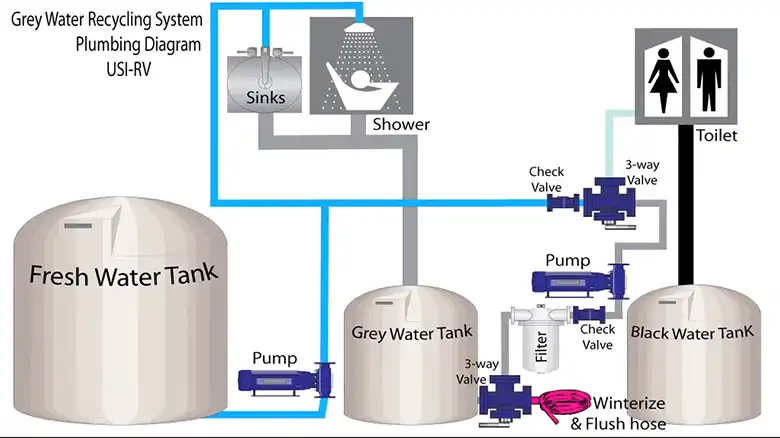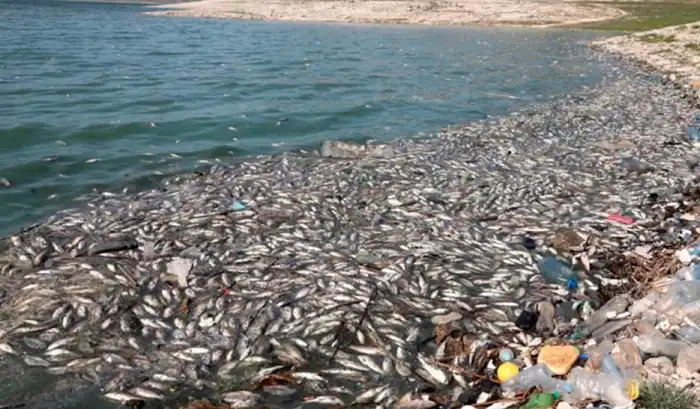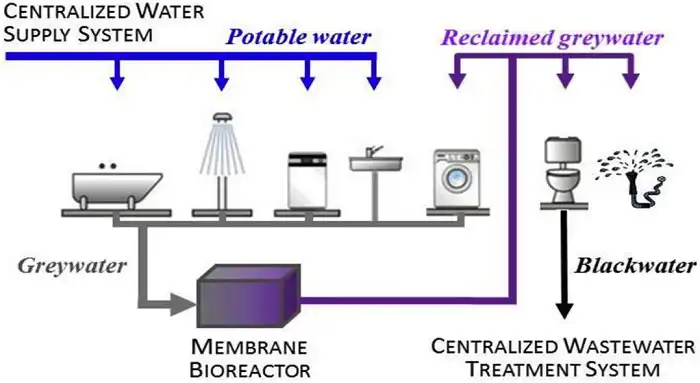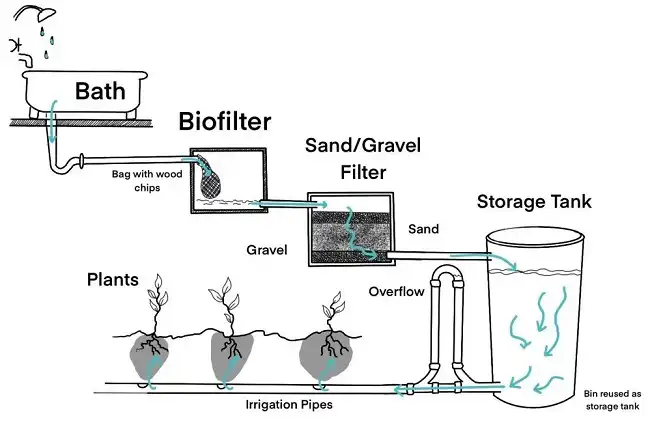Greywater disposal has become an increasing challenge for RV owners and tiny house dwellers. With limited plumbing infrastructures, the buildup of fats, oils, food scraps, and chemicals from sinks, showers, washing machines, dishwashers, and other household sources can lead to unhealthy, smelly, and even hazardous conditions if not properly dealt with.
The good news is that with some simple planning and DIY systems, greywater can be disposed of in an eco-friendly way, avoiding pollution and contamination of water sources. The key is to filter out solids and decompose organics before dispersing the cleaned greywater onto lawns, gardens, or trees.
Don’t worry, I have provided a step-by-step guide on how and where to dispose of the gray water of your RV while considering the health and environmental risks, legal considerations, filtration system options, disposal methods, maintenance tips, and pros and cons of the most common approaches. By the end, you’ll know how to set up an effective greywater system tailored to your unique needs and lifestyle. Determining the right greywater disposal solution is crucial for ensuring the safety and sustainability of life on the road or in a tiny home. So let’s get started!

Legal Options for Greywater Disposal
- RV Dump Stations: Most common legal disposal method. Overnight RV parks, campgrounds, gas stations, and highways provide dump stations to empty holding tanks. Fees are typically $10-25. Cannot dump blackwater at unofficial sites.
- Municipal Wastewater Plants: Some counties allow small volumes of RV greywater to be dumped at approved treatment facilities for a fee. More common for mobile tiny houses. Requires applying for a permit first.
- On-Site Treatment Systems: Where suitable land exists, certified greywater recycling systems can filter and purge water onsite legally. Need permitting and inspections. Useful for permanent tiny homes.
- Primitive and Dispersed Camping Sites: Some National Forests and BLM lands designate remote camping zones where greywater dispersal directly into dirt is often tolerated short-term. But taboo without digging 6” cat holes first at concentrated sites. Rules are ambiguous so check locally. Stealth dumping is never condoned.
- Farmer Land Spreading Agreements: Rarely, RVers make private arrangements with farmers to dispose of greywater as irrigation water onto cattle fields or orchards. Barter work or fees paid. Useful seasonally but reliability and regulations questionable.

Greywater Disposal Challenges
Greywater refers to wastewater generated from domestic activities such as laundry, dishwashing, and bathing which can be recycled on-site for uses such as landscape irrigation. The challenges with greywater disposal stem from:
Contaminant Build-up
Greywater contains suspended solids, fats/oils/grease, pathogens, and chemical residues. If allowed to accumulate, drain lines can clog and back up. Stagnant water also creates unpleasant odors from decomposition.
Health and Safety Risks
Improperly disposed greywater provides breeding grounds for mosquitoes, risks exposure to toxic blackwater, and can contaminate natural water bodies leading to human health implications.
Environmental Impact
Nutrient loads from greywater like nitrogen, phosphorus, and potassium can negatively impact delicate aquatic ecosystems if dispersed without adequate treatment.
Legal Restrictions
Many counties prohibit greywater dumping and have strict regulations to protect groundwater supplies which recreational vehicle (RV) owners must adhere to.

Methods for Greywater Disposal
Method 1: Greywater Storage and Hauling Systems
Portable greywater tanks offer a flexible, low-cost solution for managing wastewater volumes under 50 gallons per day. Here’s what RV owners need to know about temporary storage and hauling.
Local Regulations
Before installing any plumbing for greywater aggregation, check county codes on legal discharge. Many states prohibit dumping greywater on public roads or lands. Hauling across state lines may also require special documentation.
Essential Equipment and Tips
A basic portable setup requires:
- Collection tank: 6-50 gallon containers made of sturdy plastic resin.
- Transfer pump: 12V pump to move greywater from aggregation tanks.
- Transport: Towable greywater trailer or truck with a large holding tank.
- Protective gear: Goggles, gloves, disposable suits, and vapor masks.
Optional equipment includes gauges to monitor greywater levels and an inline filter to trap hair, food debris, and oils.

Maintenance Tips
To avoid leaks, cracks, or moldy buildup:
- Monthly inspections for any tank deterioration or faulty seals/valves.
- Yearly replacement of collection hoses and connections.
- Use enzymatic cleaners to digest organics and control odors.
Cost Considerations
- Holding tanks: $150-500
- Transfer pump: $100-250
- Used towable trailer: $2,000-5,000
- Maintenance parts/cleaners: $100-250 annually
Over one year, basic portable greywater systems cost $500-1,000 excluding dump fees. Hiring septic transport can add $200+ per pump out.
Method 2: Constructed On-Site Greywater Systems
While more complex to install, constructed wetlands, sand filters, and branching drain fields enable greywater processing at the source for recycling.
Permit Requirements and Setup
Most counties mandate permits and site inspections to install permanent greywater systems protecting local watersheds. Some rural areas though exempt RVs or temporary dwellings. Research rules early in the design process.
System Components and Maintenance
Complete on-site setups require:
- Pre-filter basin: Removes floating solids, oils, hair.
- Processing tank: Aerates water to decompose organics.
- Disinfecting: Tablet chlorinator, UV, or ozone treatment.
- Distribution: Branched drains/tubing into soil, mulch basins, or reuse tanks.
More advanced designs incorporate biological processes through constructed wetland beds or sand filters to absorb nutrients.
Maintenance Tips
Expect routine maintenance like:
- Checking/clearing pretreatment screens monthly.
- Annual chlorine tablet replacement.
- Periodic pumping of processing tanks.
- Rotating irrigation areas to prevent soil saturation.
Indicative Costs
Constructed wetland systems run $3,000-6,000 for all equipment, construction, permitting, and installation. Simpler branching drain fields $1,500-3,000. Operational costs are around $200-300 yearly for inspections, cleaning, and parts replacement.
Comparison of Disposal Methods
There are two main approaches to safely dealing with greywater – storage & hauling or building an on-site treatment system. Each has its own pros and cons:
Storage & Hauling
This involves accumulating greywater in holding tanks and periodically transporting it to an RV dump station or municipal wastewater treatment facility.
Pros:
- No permanent infrastructure is required. Easy for transient RV/tiny home living.
- Less initial investment than a full treatment system.
Cons:
- Inconvenient handling and transporting wastewater.
- Risk of leaks and spills.
- Paying dump fees.
On-Site Treatment Systems
Constructed greywater systems filter contaminants allowing liquid discharge via drip irrigation or soil infiltration.
Pros:
- Convenient, hands-off solution.
- Eliminates transport hassles and dump fees.
Cons:
- Higher upfront installation costs.
- Ongoing system maintenance is required.
- Risk of clogging or leaks.
Now let’s explore these two options in more depth, outlining legal considerations, system components, maintenance tips, and costs.
Choosing the Best Greywater Disposal Method
Deciding between temporary hauling and full treatment requires weighing convenience against costs. Consider these key factors:
- Available Space: Constructed systems need adequate real estate for processing tanks and drains. RVs can opt for attachable trailers.
- Location Duration: Frequent moves favor hauling, while permanent sites merit treatment plants.
- Water Volumes: More than 50 gallons daily requires robust filtration capability.
- Local Codes: Regional greywater dumping and treatment laws must be followed.
- Onsite Landscaping: Built systems allow beneficial garden irrigation.
- Budget: Hauling starts under $1,000 while complete planted systems run $5,000+.
In the end, every RV/tiny house scenario is unique. Work with qualified experts to tailor the best solution fitting mobility needs, water usage, and local regulations.
Bonus Tip: Is Greywater Reuse Safe?
While virtually all wastewater requires some form of treatment before reuse, properly filtered and handled greywater presents far fewer risks than combined blackwater and greywater effluent.
Studies by the World Health Organization show greywater treated through multi-stage filtration and disinfected with chlorine can be safely reused for toilet flushing and irrigation with minimal pathogens and risk of infectious disease transmission.
However, greywater can still potentially transmit communicable diseases through contact with contaminated water. Basic precautions should always be taken:
- Minimize exposed body contact with greywater
- Prevent untreated greywater access to children and pets
- Wash hands after handling greywater disposal systems
- Wear proper protective equipment like gloves and goggles
Overall though, safely reusing greywater is entirely feasible. The key is ensuring proper treatment through cost-effective, DIY methods scaled for RVs and tiny homes.
Final Thoughts
With some thoughtful planning provided in this article, handling greywater disposal can actually be simple. Tiny living presents challenges, but technology now allows a comfortable off-grid existence without sacrificing eco-friendliness. Implementing proper filtration and irrigation best practices converts greywater from a toxic nuisance into a valuable resource for watering gardens or flushing toilets. Turn wastewater into an asset rather than a liability. The options outlined here provide a roadmap to clean, odor-free, sustainable greywater management benefiting personal health and the greater environment.
Common Greywater Disposal Questions
What Are Some Diy Greywater System Options?
Some simple DIY systems include routing sinks/showers into subsurface mulch basins, digging gravel-filled leach trenches, or connecting to external water storage barrels for toilet flushing or irrigation. Always filter out solids first to prevent clogging.
How Often Should Greywater Tanks Be Emptied?
Ideally, storage tanks should be pumped out at least monthly to avoid the buildup of solids, grease, and odorous sludge. More frequent emptying is needed for smaller 6-12 gallon tanks.
Can Greywater Go Directly Into Gardens?
Untreated greywater should not be applied directly to edible gardens due to health risks. Simple sand filters or mulch basins help remove most pathogens first. Then plants filter the remaining organics.
What Chemicals Should Never Enter Greywater?
Harsh cleaners with bleaches, acids, alkalis, or disinfectants should be strictly kept out of greywater. Trace residues can easily destroy microbial ecosystems processing organics.
Can I Reuse Greywater For Drinking?
Reclaiming greywater for potable use requires very advanced treatment to remove all viruses, bacteria, protozoa plus chemical contaminants. This level surpasses most DIY systems.


